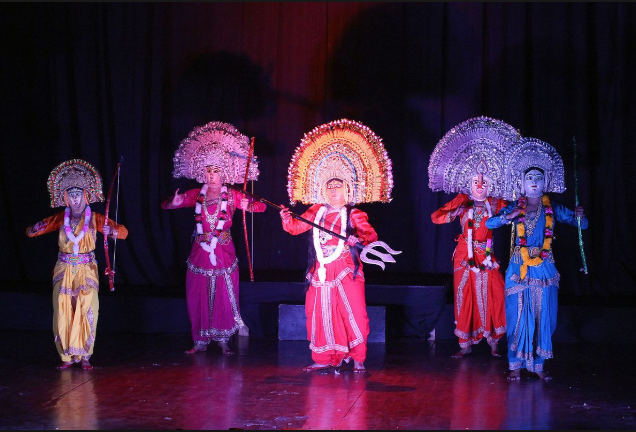Carved out of Bihar in 2000, many treasures of the relatively new state of JHARKHAND situated in Chota Nagpur Plateau is still less known to most people. It is heaven on earth, where hill streams bubble like a young adivasi’s laughter. It is here that you can hear the sound of silence, taste the elegance of nature.
Do you know which state is known as “Land of Forests”? Which state is famous for the biggest and longest Tribal Revolt in the country?
Jharkhand has underlined the distinctive tribal heritage and culture of the region as the primary reason for alternative administrative and political arrangements. This part of the blog will be telling us about the cultural, geographical and political aspects of the state but before that one must know its state symbols.
Table of Contents
State Symbols
| State Capital | Ranchi |
| State Animal | Asiatic Elephant |
| State Bird | Asian Koel |
| State Tree | Sal |
| State Flower | Palash |
| State Dance | Chhau |
| State CM (Present) | Hemant Soren |
| State Governor (Present) | Draupadi Murmu |
Now, let’s begin with the different aspects of Jharkhand. The first one that’s on our list is –
CULTURE Jharkhand GK Notes
The vibrant culture of Jharkhand is highly influenced both by the tribal and the non-tribal community people. Many tribes have inhabited this part of the country because of which the state has emerged as an important multi-ethnic state.
Festivals and Fairs
The communities of Jharkhand have a rich culture and tradition with several colourful festivals and fairs.
- Karam – It is a major native festival of Jharkhand and is celebrated on the 11th day of full moon of the month of Bhado by the Sadan and the tribal people of Jharkhand. During this festival, people bring branches of the Karam tree to the village and place them on the ground. The branches are washed with milk and handia, and decorated with garlands, curd, rice, flowers and grains.
- Poush Mela – It is also known as Tusu Fair and is a significant occasion celebrated during the Makar Sankranti wherein brightly coloured and decorated artifacts of folk deity are carried by the people. This is a folk harvesting festival. Tusu is a folk belief, not about any God or Goddess, but about a sweet little girl of the tribal folk. The festival takes place as new crops are harvested.
- Lawalong Mela – Lawalong Mela is one of the most popular and the biggest cattle fairs in Jharkhand, which is held each year on the propitious day of Aghan Purnima which falls in the long stretch of November/December. It is an ancient fair that started from about the year 1880. Since then till now, the Lawalong Mela has taken place almost every year. Other cattle fairs in the district of Jharkhand are also pretty well known and visited by a number of people from all over the state. These fairs are the Chatra Mela, the Kundra Mela and the Kolhaiya Mela in Chatra, the Tutilawa Fair and the Belgada Mela of Simaria.
- Jitia – During the festival of Jitia, mothers fast for the wellbeing of their children. It is celebrated from the seventh to the ninth lunar day of Krishna-Paksha, in the month of Ashwin.
- Sarhul – Sarhul is a spring festival celebrated during spring season when the Saal trees get new flowers on their branches. It includes the worshipping of the village deity who is considered to be the protector of the tribes. People sing and dance a lot when new flowers appear. The deities are worshipped with Saal flowers.
- Jawa – This is a festival which is celebrated by the unmarried tribal girls, which has its own kind of songs and dance. This is held mainly for the expectation of good fertility and better household.
Dance
- Chhau Dance – Chhau Dance, also spelled as Chau or Chhaau, is a semi-classical Indian dance with martial, tribal and folk traditions, with origins in eastern India. It is found in three styles named after the location where they are performed, i.e. the Purulia Chau of Bengal, the Seraikella Chau of Jharkhand, and the Mayurbhanj Chau of Odisha.
- The dance ranges from celebrating martial arts, acrobatics and athletics performed in festival themes of folk dance, to a structured dance with religious themes found in Shaivism, Shaktism and Vaishnavism. The stories enacted by Chhau dancers include those from the Hindu epics the Ramayana and the Mahabharata, the Puranas and other Indian literature.
- Some of the other famous dance forms are Jhumair, Domkach, Lahasua, Fagua, Paika, Hunta Dance, Mundari Dance, Barao Dance, etc.
Food and Language
- The official language of Jharkhand is Hindi and is mostly spoken among people while the state converse in a number of other languages like Bengali, Angika, Kurukh, Mundari, Santali and Ho.
- Talking about the food of Jharkhand, it’s not much different from its neighbouring state Bihar. They prefer to eat wheat, rice and vegetables cooked in Sunflower Oil and Mustard Oil.
- Arsa, Dhuska, Chhilka, Koinar Sag, Grenn Sag, Dubki, Udad Dal, Kurthi Dal, Litti-Chokha, Sattu Parantha, Pitha, Khapada, Roti, Mitha Pitha and Kudrum ki Chatni are the famous delicacies.
- The popular cuisines include local varieties. Dhuska is a dish made from rice. It is prevalent in tribal houses.
- Some of the non-vegetarian foods are Mudwa Khussi Meat, Duck Meat, Deshi Chicken and Tengara Fee. Bamboo-shoots are also widely famous.
Handicraft and Clothing
- The main dress of women is saree and blouse. Tribal women usually wear Parthan and Panchi. While the non-tribal women wear modern costumes or sari with a blouse.
- Bhagwan is a single piece of cloth worn by men. The Santhal Pargana tribe men Santhals and Paharis to give them a unique look. While men also wear Kurta-Pyjama or dhoti while shirts and trousers are also worn. One can easily find high-class Tussar Silk here.
- The Paitkar Painting is a special type of folk painting In Jharkhand. This form of painting is one of the earliest forms of tribal paintings in India and thus enhances the culture of Jharkhand.
- The ‘Painted Mask’ tradition of Jharkhand is truly legendary. In the early days, masks were made of leaves, but today’s highly stylized masks use a variety of materials like wood, pumpkin, gourd, cloth, even paper masks.
Nature wears her best clothes in this state. The state is endowed with abundant flora and fauna. Now, it’s time to look into the geographical aspect.
GEOGRAPHY Jharkhand GK Notes
Jharkhand is located in the north-eastern part of the country. Most of the Jharkhand state is still enclosed by forest. Forests sustain the population of wildlife.
- Latitudinal Extension – 830 22’ to 870 57’ N
- Longitudinal Extension – 210 58’ to 250 18’ E
- Area – 79,714 km
Rank in India – 15th
- Population – 32,988,134
Rank in India – 14th
- Literacy rate (According to the 2011 census) – 67.6%
- Boundaries – The state shares its border with the state of Bihar in the north, Uttar Pradesh to the northwest, Chhattisgarh to the west, Odisha to the south and West Bengal to the east.
- The most prominent physical feature of Jharkhand is the Chota Nagpur Plateau, part of the Deccan Plateau that occupies most of peninsular India. Chota Nagpur Plateau is actually a series of plateaus, hills and valleys, covers nearly the entire state and consists primarily of crystalline rocks. Many rivers pass through Chota Nagpur Plateau such as Damodar, North Koel, South Koel, Sankh, Brahmani and Subarnarekha Rivers.
- The main plateaus, Hazaribagh and Ranchi, are separated by the faulted sedimentary coal-bearing basin of the Damodar River, and they average about 610 metres in elevation.
- The highest point in Jharkhand is formed by the conical granite peak of Parasnath, which rises to 1366 metres on the Hazaribagh Plateau. Parasnath Hill is also recognized as Sri Sammed Sikharji. It is sacred in the Jain religion and to the Santhal people.
- Apart from the Damodar River in the north-east, the state is drained by the Subarnarekha River in the south-east and by the Brahmani River in the south. A third major river, the Son, runs along much of the north-western state boundary.
- Climate – There are three well-defined seasons in Jharkhand. Firstly, the cold-weather season extends from November to February and it is the most pleasant part of the year. Secondly, the hot-weather season extends from March to mid-June. May is the hottest month. The season of the southwest monsoon, from mid-June to October, brings nearly all of the state’s annual rainfall. Rainfall on the plateau is generally heavier than on the plains. Nearly half of the annual precipitation falls in July and August.
- Soils – Soil content of Jharkhand state mainly consists of soil formed from the disintegration of rocks and stones, and soil composition is further divided into –
- Red soil, found mostly in the Damodar valley, and Rajmahal area.
- Micacious soil (containing particles of mica), found in Koderma, Jhumri Telaiya, Barkagaon, and areas around the Mandar Hills.
- Sandy soil, generally found in Hazaribagh and Dhanbad.
- Black soil, found in Rajmahal area.
- Laterite soil, found in the western part of Ranchi, Palamu and parts of Santhal Parganas and Singhbhum.
Now, let’s come to the next and last aspect i.e. –
POLITY Jharkhand GK Notes
The Government of Jharkhand also known as the State Government of Jharkhand, or locally known as State Government, is the supreme governing authority of the Indian state of Jharkhand. It consists of an executive, led by the Governor of Jharkhand, a judiciary and a legislative branch.
- The present Legislative Assembly of Jharkhand is Unicameral, consisting of 81 Members of the Legislative Assembly (MLA). Its term is five years unless dissolved earlier.
- Like other states of India, the head of the state of Jharkhand is the Governor, appointed by the President of India on the advice of the central government. His or Her post is largely ceremonial.
- The Chief Minister is the head of the government and is vested with most of the executive powers.
- Ranchi is the capital of Jharkhand and houses the Vidhan Sabha (Legislative Assembly) and the secretariat.
- The Jharkhand High Court, located in Ranchi, has jurisdiction over the whole state. The present Chief Justice is Dr. Ravi Ranjan.
- Representation in Parliament –
Lok Sabha – 14
Rajya Sabha – 6
- The present and 5th CM of Jharkhand is Hemant Soren since 2019. He is also the president of JMM (Jharkhand Mukti Morcha), a political party in Jharkhand.
- The present and 8th Governor of Jharkhand is Draupadi Murmu since 2015. She is the first governor of Jharkhand to complete the five year term, since its formation in 2000.
- The first CM of Jharkhand is Babulal Marandi. He hailed from BJP (Bhartiya Janta Party). His term of office was 15 November 2000 – 18 March 2003.
- The first governor of Jharkhand was Prabhat Kumar. His term of office was 15 November 2000 – 3 February 2002.
Here comes Some of the Interesting Facts about Jharkhand –
- Birsa Munda Revolt is the biggest and longest Tribal Revolt in the country against the British Raj. It started in 1895 and lasted till 1900s.
- Jamshedpur, the largest city of Jharkhand, is the only city in India with a population of more than one million that has no Municipal Corporation. The Tatas have been running the administration of the city. Jamshedpur is the first well planned industrial city in India. It was founded by Jamshedji Tata in 1907.
- SS Ranchi British Vessel was named after Ranchi. It Ferried between London and Bombay and also served as an armed merchant cruiser HMS Ranchi, during World War 2.
- Jharkhand has been at the centre of the Naxalite-Maoist Insurgency.
- The Largest Indian Flag with the tallest flagpole is hoisted at Pahari Mandir in Ranchi. It weighs 60 kg and has a dimension of 66 feet by 90 feet.
Hope this part helped you in getting the complete information related to the above aspects which are really important from the point of view of your competitive exams such as CDS, BANK PO, SSC CGL, etc. In our upcoming blog, we will be learning about the other aspects of Jharkhand. If you don’t want to miss it, click here – Know your State ‘Jharkhand’ – Part 2.
Thank You




